
There are very few people who do not face a problem like body warts. These growths can occur on the body in adolescents, adults, and the elderly. Usually, warts are just a cosmetic problem, degrading a person's appearance. And only in rare cases do these formations actually pose a health threat.
What are warts?
Our skin has a smooth surface. However, in some cases, there may appear raised nodules on the skin. These are called warts. Usually these are permanent formations that have not changed for many years.
The mechanism by which warts appear is the growth of the top layer of the skin. The size of the formations ranges from 1 mm to several centimeters. This parameter depends on the type of formation and its location on the skin. The combination of several warts is often observed. The color of the developed skin is usually flesh color, but they can have other shades, such as pink or brown.
Medically classifies warts as benign tumors. They do not grow and do not invade surrounding tissues.
In the International Classification of Diseases, the following codes are assigned to warts:
- B07 - viral warts,
- A63. 0 - venereal warts,
- L82 Seborrheic Keratoma
Most types of warts are viral, sexually transmitted warts are venereal, and varicella are senile warts that are not contagious.
The following skin lesions should be distinguished from warts:
- nevi (mole),
- calluses,
- malignant tumors,
- basal cell carcinoma,
- Extensive warts caused by syphilis.
Some formations can be life-threatening. Therefore, if any suspicious formations appear on the body, it is necessary to consult a doctor.
Why do warts happen?
Usually, a viral infection is what causes warts. The appearance of warts takes place as follows. The human papilloma virus invades skin cells and causes them to divide rapidly. As a result, a lump or papilloma develops on the skin. However, there are types of warts where the virus has nothing to do with it.
Strictly speaking, papillomas do not always occur on the skin. Often these formations are found on mucous membranes, inside the bladder, in the larynx, on the cervix, etc. v. However, people often refer to warts as just papules that appear on the skin.
Warts can be on any part of the body. However, some species have their favorite places. For example, warts often form in the groin and anus; acrochords prefer the folds of skin on the upper body.
The human papillomavirus does not multiply outside the body. However, it can persist for a long time in warm and humid places. That's why people can often get sick from going to a bathhouse, sauna, or swimming pool. But the virus doesn't live long in the air - it is neutralized by the Sun's ultraviolet radiation.
According to studies, about 80% of the world's population is infected with some type of human papilloma virus. There are two hundred strains of this virus in total. Some viruses are relatively harmless, others lead to papillomas, and others can even cause malignancies. Some strains can be passed from person to person. Therefore, certain types of warts can be contagious. But transmission of diseases from frogs and toads, as well as from other representatives of the fauna, is, contrary to popular belief, impossible. This is explained by the fact that animal papillomas do not multiply in the human body.
You can get a new virus through personal contact, shaking hands, sharing household items (for example, towels), when going to public places (swimming pools, bathtubs, saunas, traffic), through minor injuries and through sex.
The papilloma virus that has entered the body does not always cause the disease. Often, factors associated with disease are stress, reduced immunity (eg, due to infectious diseases). At the same time, the virus can stay in the body for several years and wait in the wings.
Types of warts
Doctors distinguish several types of warts:
- normal (vulgar),
- youthful (flat),
- sharp (condylomas),
- old age,
- like thread.
Birthmarks (nevi) should be kept separate from these types of warts. Usually, birthmarks do not protrude from the surface of the skin and are dark in color, although there are exceptions.
Warts
This type of wart occurs in 70% of cases. It is caused by the papilloma virus. Outwardly, vulvar papillomas (normal) look like small semicircles on the surface of the skin. They are usually completely painless. The size of the formations ranges from a few millimeters to 1 cm, their surface is often uneven, bumpy, often resembling the surface of cauliflower. Color - flesh-colored, grayish, golden brown. Frequent localization - hands, face, fingers, lips, knees, elbows. Mucous membranes are rarely affected.
Usually, common papillomas go away on their own. A special feature of this type of papilloma is that they often grow not alone, but in groups. You can often find a large papilloma surrounded by small growths. If you remove the largest (mother) papilloma, then usually the small papillomas will go away.
Common papillomas can occur at any age. They usually occur in school-age children.

Teenage warts
This type of papilloma often appears in children and adolescents. But in people of adulthood, they can also appear. These papillomas are also commonly referred to as flat papillomas. They make up only 4% of all warts.
They can often be found on hand. They can also be observed on the feet and face, near the fingernails, between the toes, on the legs and on the neck. They are often related to hormonal changes in the body. Like common papillomas, they pose no significant danger and may resolve on their own. They do not usually cause physical discomfort but can worsen the appearance.
Flat papillomas are usually flesh-colored and protrude only slightly (about 1–2 mm) above the skin's surface. They can reach 5 mm in diameter, but they are usually smaller than the vulgar ones. Flat papillomas can occur near wounds and cuts. Usually juvenile papillomas have a smooth surface and an uneven, although clear, border. Due to the lack of stratum corneum on the surface, they can look shiny.
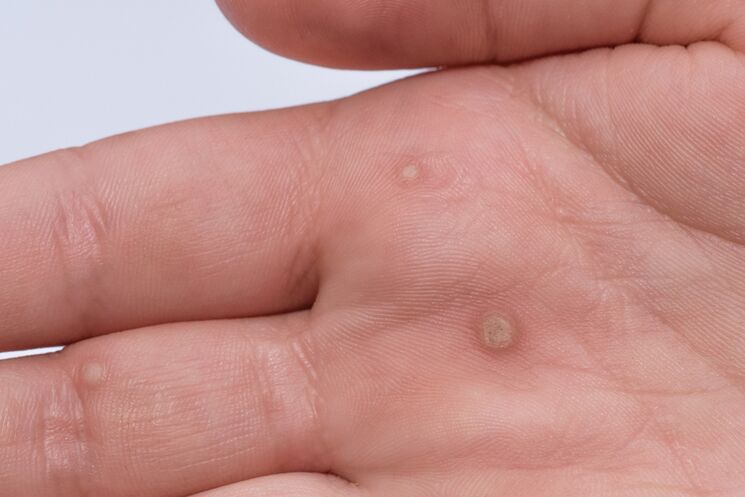
Plantar warts
This is an extremely uncomfortable type of skin growth that occurs on the feet. They are sometimes mistaken for corn cobs. However, plant papillomas have one feature that distinguishes them from corn. If the wart is damaged, it will usually bleed. For maize, this phenomenon is not typical. Although superficially, foot papillomas can look like calluses - they are often hard and thickened. Their color is usually dirty gray, dark or dirty yellow with a brown tint. Black dots may appear on their surface.
Usually, a plantar wart is found on the foot. But they can also meet in groups, as well as grow together. Plant papillomas not only develop on the outside of the skin but also grow deeper.
On the surface, these warts may look like regular warts. They are usually semicircular in shape. However, if a person repeatedly develops such a skin formation, it can take on a flat form.
The appearance of papillomas on the soles of the feet has little to do with age, they can appear in both young and old people. These formations can also be observed in children.
Plantar papillomas can cause discomfort and even severe pain when walking. When you step on such a tumor, it looks like you are stepping on a small pebble. Outwardly, warts can sometimes resemble spikes. Therefore, folk call this type of papilloma.
In a calm state, these formations can cause itching. Like other types of papillomas, warts develop under the influence of the papilloma virus. Viruses often enter the skin of the feet from the environment. For example, it is not uncommon for you to get this virus when you go to the pool without rubber shoes. Uncomfortable shoes also contribute to the appearance of skin lesions, as they often occur where shoes rub against the foot. Excessive sweating and inadequate foot hygiene are also contributing factors.
Do not touch papillomas on the soles of your shoes with your hands, as you can spread the virus to other areas of skin.
Plantar warts treatment
Sometimes papillomas of this type go away on their own. This happens in about half of the cases. But sometimes it takes a long time to wait for this moment, and not everyone can afford it, especially if education makes you feel painful. If the growth on the foot causes severe pain and is not allowed to walk, it must be removed. In addition, education more than 1 cm must be removed. Surgical excision can only be done in a doctor's office.
If there is any doubt that the formation on the leg belongs to any type of papilloma, the doctor can conduct several diagnostic procedures. These include scraping and analysis of the stratum corneum, and PCR analysis for the presence of the papilloma virus genome. To determine the shape and size of the formation, ultrasound is performed. Leg warts require a differential diagnosis from syphilis warts. Usually, however, extensive diagnostic measures are not taken, as papillomatosis is not difficult to diagnose.
Sometimes, you can try medication to get rid of a lump on your foot. For the removal of warts, preparations with salicylic acid, necrolysis agents, freezing sprays and special patches are suitable. However, drug removal is usually not a quick procedure. You can quickly remove warts on the soles only with the help of tools available in medical facilities. These can be methods:
- laser,
- surgery,
- condenser,
- cryodestruction,
- radio waves.
Any type of procedure has its own pros and cons. For example, surgery is used mainly for large skin growths, as it severely damages the skin.
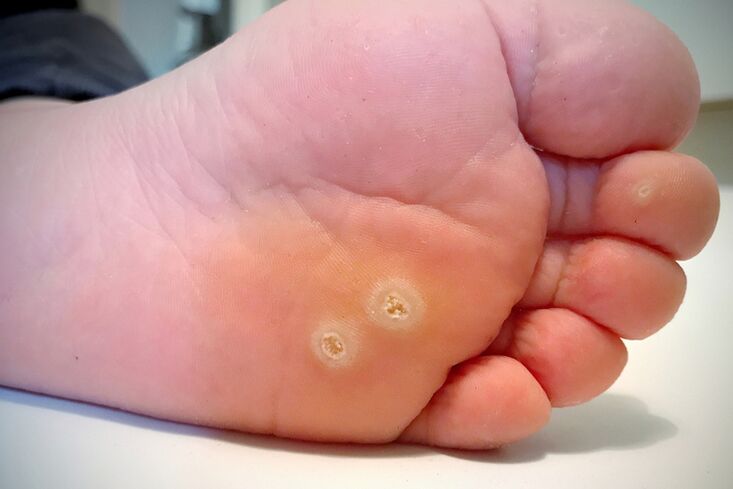
Genital warts
This is a special type of wart. They are usually found in the genital area. Their shape is also unusual, as they look like papillae (hence the name). However, warts can also be irregularly shaped, like cauliflower or warts. The virus that causes this type of wart is usually sexually transmitted. In addition, tumors can be observed on the mucous membranes, in the anus. Therefore, such warts are often referred to as genital or venereal warts. Less commonly, mammary gland tumors are found in the armpit, in women below the mammary gland. Warts range in color from flesh to pink. Sometimes several genital warts can develop together. In addition, the condylomas of this species can grow to large sizes. Warts can cause pain during intercourse or defecation. If injured, they may bleed. Women with genital warts can also develop cervical cancer.
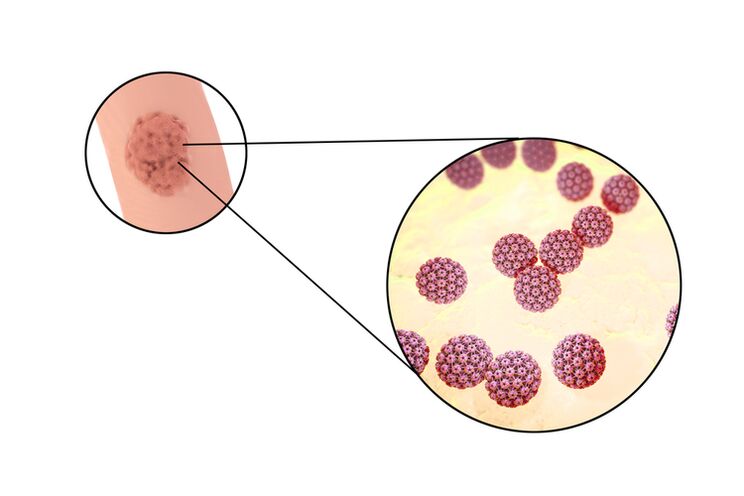
Filiform warts
This is an extremely common type of wart. Filiform warts, also known as warts, usually grow in large groups. Prefer the acrochord for thin skin areasThis is the skin of the armpits, neck, shoulders, eyelids, nose wings. It can be found in the groin area, under the mammary glands in women. They usually don't bother a person and are painless, but they can itch.
Externally, filamentous warts resemble long threads. However, the acrochord is often found to have a thin thread body to which the thick stem is attached, usually spherical or hemispherical. They are also fibrous. Such warts are called warts.
Most of these warts are between 1 mm and 5 mm in size. There are also gourds larger than 1 cm. Sometimes several filamentous warts grow together.
Acrochords are rare in children. They are specific to people over the age of 35. And over the years, their numbers have often increased. In people over 70 years old, this type of warts is observed 100%. The tendency to have a large number of gourds on the body can also be inherited. Acrochords are often associated with being overweight. In women, they can occur during pregnancy.
Fibrous warts have an unpleasant feature. If the filamentous wart is torn off, a new wart will soon grow in its place. Acrochords rarely pass on their own. Their appearance is promoted by increased sweating, decreased immunity.
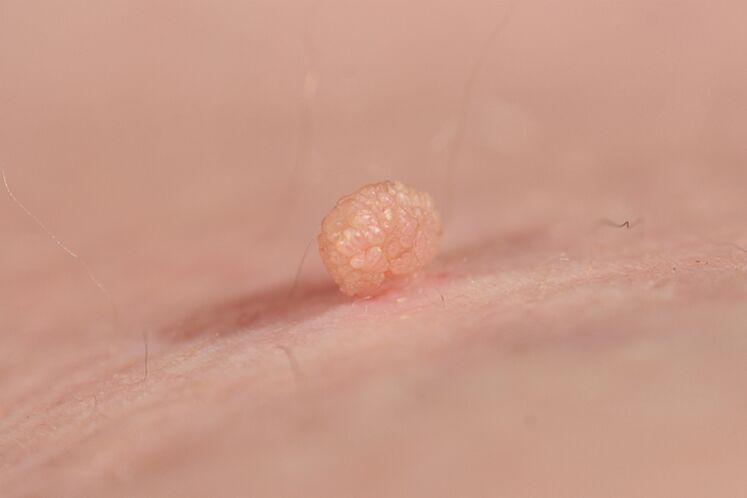
Old age warts
This type of wart has another name - seborrheic keratosis. It usually occurs in people over 60 years of age. Unlike other types of warts, senile keratosis is not caused by the human papillomavirus. The exact reason for their appearance has not yet been established. Keratomas are most likely related to age-related changes in the body. They develop from the basal layer of the epidermis, which is why they are often called basal cell papillomas. Although this is not the exact name, because papillomas are actually caused by a virus. Heredity plays an important role in the occurrence of these tumors. Age-related melanoma can often resemble melanoma. Therefore, if they occur, it is necessary to consult a doctor so that a diagnosis can be made. However, senile keratosis usually does not require treatment and does not turn into malignancy.
Outwardly, keratosis looks like pink or yellowish papules with a thickness of 1-2 mm. Their size ranges from 2 mm to 3 cm, sometimes these warts are 4-6 cm in size. Keratomas have a fatty, easy-to-remove shell. Their surface is uneven, as if there are folds. As they grow older, keratoses often resemble mushroom caps and their color changes to black or dark brown. Their surface becomes hard, they can crack.
Usually, keratosis is located on the neck and chest. Group observations can be made. They appear less often on the hands and face. They do not exist on mucous membranes. Usually, there are no more than 20 keratosis cysts on the body, if a person has many warts in old age, it is usually due to genetic factors.
Age-related keratosis does not go away on its own. People who have too many cysts on their body should increase the amount of vitamin C in their diet to prevent new growth. You should also avoid exposure to direct sunlight, overheating, hypothermia, stress.
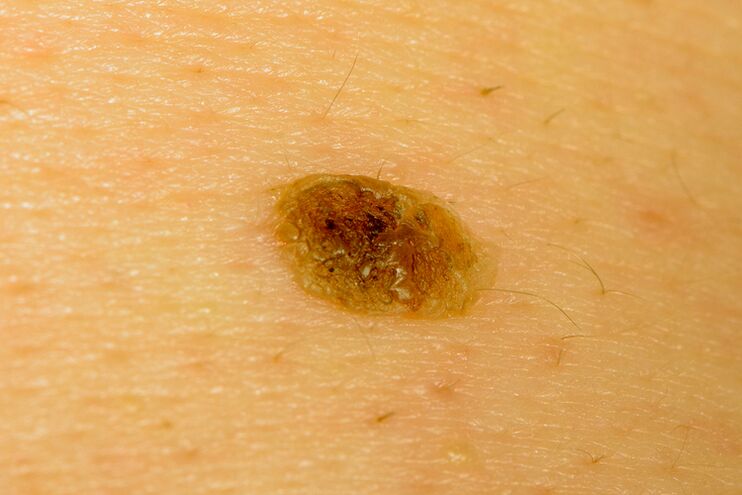
Treatment
Most papillomas do not pose a serious threat. However, after the injury, they may experience pain and bleeding. Then there is a risk of developing malignancies. Although in papillomas and keratomas, the risk of malignancy is much lower than in moles.
Papillomas are usually treated by excision (surgery, with the help of high-frequency electric current or cold laser). Therapeutic treatments are often less effective.
Indications for excision are painful skin formations, large size, bleeding, change in shape, location in an uncomfortable place (eg, on top of toes, soles of feet, genital area), weightabout aesthetics. Warts can also be removed.














































































